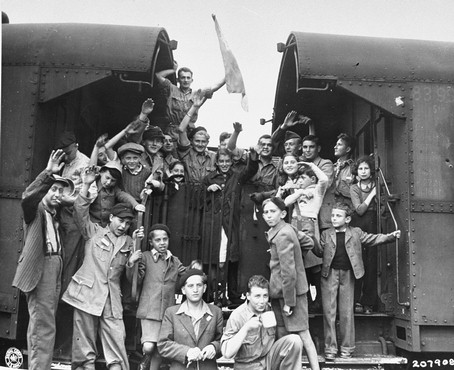I have blogged several times in the past about the one-day student trips to Auschwitz, sponsored by the HET. I highly disapprove of these propaganda trips.
Today I read about yet another student trip in a news article at http://www.bristolpost.co.uk/Learning-horrors-Auschwitz/story-20883729-detail/story.html
This quote is from the news article:
We walked the 1,000 steps from the entrance [into Auschwitz-Birkenau] to what’s left of the [Krema II and Krema III] gas chambers. Two huge underground buildings where thousands were led to believe they could take a shower. Edyta [the Jewish tour guide] explained that each chamber could hold 2,000 people, who were killed in just 15 minutes. Their bodies were then mass cremated or burned in a nearby forest and used as fertiliser around the camp.
What does “mass cremated” mean? Were there huge cremation ovens at Auschwitz where the bodies were “mass cremated”? Before the Auschwitz camp was abandoned by the Germans, the cremation ovens were lifted out of the Birkenau crematoria and taken to Germany to be used in other camps.
Apparently, even with mass cremation, the Nazis had to resort to burning the bodies in “a nearby forest.” What about the danger of starting a forest fire, which could have burned the whole countryside for miles around?
And using the ashes of the Jews for “fertiliser”? There were farms, just outside the Auschwitz-Birkenau camp, where fertilizer was used, but I doubt that Heinrich Himmler, who had a degree in Agriculture, would have used the ashes of Jews for fertilizer.
The news article continues with this quote:
Earlier in the day we were taken to a synagogue in the small town of Oswiecim, better known by its German name of Auschwitz. […]
Rabbi Marcus showed students some Jewish prayer books and explained that once they became unusable they were ceremoniously buried in cemeteries along with religious scrolls. Hearing that helped me put it all into perspective; to a Jewish person, a book is worthy of a burial. To a Nazi, a Jewish person was not even worthy of that.
There were 6 million Jews killed in the Holocaust. Did the Jews really expect the Nazis to bury each body in an individual grave?
The news article continues with this quote:
Throughout the day, educators had urged students to try to remember the individual people who lost their lives at Auschwitz, and the last part of the tour was dedicated to just that.
As Edyta [the tour guide] explained, the room [in the Sauna building] where Jews were sent to register was where they were stripped of their identities. “When they left this room they stopped being a person, a human being. They became a number. They became a nothing.” But now that very room is used to remember the human beings behind the numbers.
Wedding and baby photos line the walls. Pictures of families, first days at school – I even spotted two teenage girls in what looked like an early selfie.
These smiling happy people were a far cry from the earlier uniformed photos lining the walls [in buildings in the main Auschwitz camp].
The quote above refers to the photos which have been put up in the Sauna building, where incoming Jews were brought to take a shower and have their heads shaved to get rid of any lice, which could have started a typhus epidemic. Why did the Nazis save all those photos, which were brought to the camp, by the Jews?
Instead of telling the British students the truth, that the Germans tried to save lives by giving the Jews showers and shaving the hair off their heads, the students were told that the Sauna building was where the Jews were “stripped of their identities,” and where they “stopped being a human being.”
Did the guide explain that the Jews believe that Jews are the only human beings, and that the non-Jewish “goyim” are animals, not human beings?
The Jews “became a number” when they entered Auschwitz. What if the Germans had not given each Jew a unique number? How many Jews, who had the exact same name, were in Auschwitz? Each prisoner was given a unique number which identified them and distinguished them from other prisoners with the same name.
Did the tour guide explain to the students that the Jews had the habit of killing children and leaving their bodies to be found? The Jews did not bury the bodies of non-Jewish children because they believed that these children were not human, and only human beings should be buried.
A blog post, written by another blogger, explains it. You can read this blog post at
This quote from the blog, cited above, tells about how Jews were killed in Poland, after World War II, because of a ritual murder:
On July 4, 1946, 42 Jews who had survived the Nazis were butchered by their own countrymen:
The pogrom followed a series of violent anti-Semitic incidents in the Kielce region and elsewhere in Poland after 1945, which claimed about 2,000 Jewish victims. The local violence was directed at former Jewish residents of Kielce who had survived the camps or hidden in the forests until the liberation of Poland from Nazi rule; it occurred at a time of intense anti-Semitic hatred, when rumors were rampant that masses of Jews would soon return to Poland from the USSR to reclaim their houses and belongings.
The more immediate cause was the ritual murder myth, which had been widely disseminated by the Catholic Church in between-the-wars Poland and was still believed by many lower-class Poles.
Rumors had begun to spread in June 1946 that Jews on Planty Avenue in Kielce were killing Polish children and drinking their blood or using it to make matzot. One Jewish eyewitness who survived the pogrom remembered: “At about nine o’clock, on 4 July, crowds started to surround the building. I heard voices from the crowd: ‘You Jews have killed 14 of our children! Mothers and fathers unite to kill all the Jews!’”




















